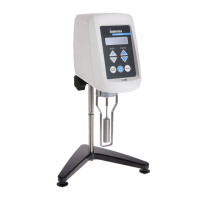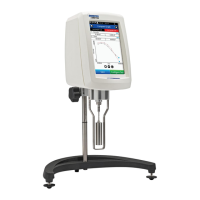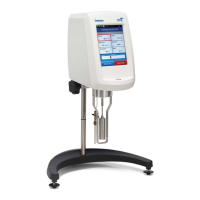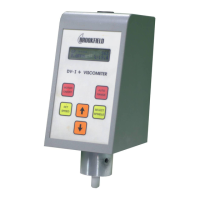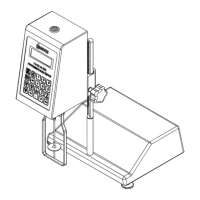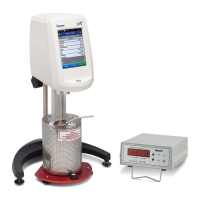Brookeld Engineering Laboratories, Inc. Page 39 Manual No. M14-023
When taking viscosity measurements with the DV1 Viscometer, there are two considerations, which
pertain to the low viscosity limit of eective measurement.
1. Viscosity measurements should be taken within the equivalent % Torque Range from 10%
to 100% for any combination of spindle/speed rotation.
2. Viscosity measurements should be taken under laminar ow conditions, not under turbulent
ow conditions.
e rst consideration has to do with the accuracy of the instrument. All DV1 Viscometers have
a Full Scale Range allowable error of (+/-) 1% of any spindle/speed in use. We discourage taking
readings below 10% of range because the potential viscosity error of (+/-) 1% is a relatively high
number compared to the instrument reading.
e second consideration involves the mechanics of uid ow. All rheological measurements of
uid ow properties should be made under laminar ow conditions. Laminar ow is ow wherein
all particle movement is in layers directed by the shearing force. For rotational systems, this means
all uid movement must be circumferential. When the inertial forces on the uid become too great,
the uid can break into turbulent ow wherein the movement of uid particles becomes random
and the ow cannot be analyzed with standard math models. is turbulence creates a falsely high
viscometer reading with the degree of non-linear increase in reading being directly related to the
degree of turbulence in the uid.
For the following geometries, we have found that an approximate transition to the onset of turbulent
ow occurs in the following situation:
1) No. 1 LV Spindle: 15 cP at 60 RPM
2) No 2 LV Spindle: 100 cP at 200 RPM
3) No. 1 RV Spindle: 100 cP at 50 RPM (optional spindle available from Brookeld)
4) UL Adapter: 0.85 cP at 60 RPM
Turbulent conditions may exist in these situations whenever the RPM/cP ratio exceeds the values
listed above. e viscosity at which turbulence starts is still at best a guess because it is a relationship
between viscous and inertial forces, and it can vary dramatically from uid to uid. Turbulence
starts as a small deviation or increase in viscosity for a Newtonian uid and grows quickly. Basically,
there is no specic shear that it starts at, only an approximate region of shear depending on the uid.

